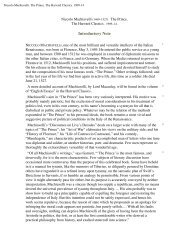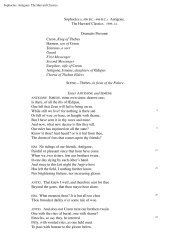Notre Dame de Paris - Bartleby.com
Notre Dame de Paris - Bartleby.com
Notre Dame de Paris - Bartleby.com
You also want an ePaper? Increase the reach of your titles
YUMPU automatically turns print PDFs into web optimized ePapers that Google loves.
shot-holes than with windows, its drawbridge always raised, its portcullis always lowered—that is the<br />
Bastile. Those objects like black beaks projecting from the embrasures of the battlements, and which,<br />
from a distance, you might take for rain-spouts, are cannon. Within their range, at the foot of the<br />
formidable pile, is the Porte Saint-Antoine, crouching between its two towers.<br />
Beyond the Tournelles, reaching to the wall of Charles V, stretched in rich diversity of lawns and<br />
flower-beds a velvet carpet of gar<strong>de</strong>ns and royal parks, in the heart of which, conspicuous by its maze of<br />
trees and winding paths, one recognised the famous labyrinthine gar<strong>de</strong>n presented by Louis XI to<br />
Coictier. The great physician’s observatory rose out of the maze like a massive, isolated column with a<br />
tiny house for its capital. Many a terrible astrological crime was perpetrated in that laboratory. This is<br />
now the Place Royale.<br />
As we have said, the Palace quarter, of which we have en<strong>de</strong>avoured to convey some i<strong>de</strong>a to the rea<strong>de</strong>r,<br />
though merely pointing out the chief features, filled the angle formed by the Seine and the wall of<br />
Charles V on the east. The centre of the Town was occupied by a congeries of dwelling-houses. For it<br />
was here that the three bridges of the City on the right bank discharged their streams of passengers; and<br />
bridges lead to the building of houses before palaces. This collection of middle-class dwellings, closely<br />
packed together like the cells of a honey<strong>com</strong>b, was, however, by no means <strong>de</strong>void of beauty. The sea of<br />
roofs of a great city has much of the gran<strong>de</strong>ur of the ocean about it. To begin with, the streets in their<br />
crossings and windings cut up the mass into a hundred charming figures, streaming out from the Halles<br />
like the rays of a star. The streets of Saint-Denis and Saint-Martin, with their innumerable ramifications,<br />
went up si<strong>de</strong> by si<strong>de</strong> like two great trees intertwining their branches; while such streets as the Rue <strong>de</strong> la<br />
Plâterie, Rue <strong>de</strong> la Verrerie, Rue <strong>de</strong> la Tixeran<strong>de</strong>rie, etc., wound in tortuous lines through the whole.<br />
Some handsome edifices, too, thrust up their heads through the petrified waves of this sea of gables. For<br />
instance, at the head of the Pont-aux-Changeurs, behind which you could see the Seine foaming un<strong>de</strong>r<br />
the mill-wheels of the Pont-aux-Meuniers, there was the Châtelet, no longer a Roman keep, as un<strong>de</strong>r<br />
Julian the Apostate, but a feudal tower of the thirteenth century, and built of stone so hard that three<br />
hours’ work with the pick did not remove more than the size of a man’s fist. Then there was the square<br />
steeple of Saint-Jacques-<strong>de</strong>-la-Boucherie, with its richly sculptured corners, most worthy of admiration<br />
even then, though it was not <strong>com</strong>pleted in the fifteenth century; it lacked in particular the four monsters<br />
which, still perched on the four corners of its roof, look like sphinxes offering to mo<strong>de</strong>rn <strong>Paris</strong> the<br />
enigma of the old to unriddle. Rault, the sculptor, did not put them up till 1526, and received twenty<br />
francs for his trouble. There was the Maison-aux-Piliers, facing the Place <strong>de</strong> Grève, of which we have<br />
already given the rea<strong>de</strong>r some i<strong>de</strong>a; there was Saint-Gervais, since spoilt by a doorway “in good taste”;<br />
Saint-Méry, of which the primitive pointed arches were scarcely more than circular; Saint-Jean, whose<br />
magnificent spire was proverbial; and twenty other edifices which disdained not to hi<strong>de</strong> their won<strong>de</strong>rs in<br />
that chaos of <strong>de</strong>ep, dark, narrow streets. Add to these the carved stone crosses, more numerous at the<br />
crossways than even the gibbets; the cemetery of the Innocents, of whose enclosing wall you caught a<br />
glimpse in the distance; the pillory of the Halles, just visible between two chimneys of the Rue <strong>de</strong> la<br />
Cossonnerie; the gibbet of the Croix du Trahoir at the corner of the ever-busy thoroughfare; the round<br />
stalls of the Corn Market; fragments of the old wall of Philip Augustus, distinguishable here and there,<br />
buried among the houses; moul<strong>de</strong>ring, ivy-clad towers, ruined gateways, bits of crumbling walls; the<br />
quay with its myriad booths and gory skinning yards; the Seine, swarming with boats from the Port au<br />
Foin or hay wharf to the For l’Evêque, and you will be able to form some a<strong>de</strong>quate i<strong>de</strong>a of what the great<br />
irregular quadrangle of the Town looked like in 1482.<br />
Besi<strong>de</strong>s these two quarters—the one of palaces, the other of houses—the Town contributed a third










